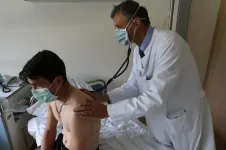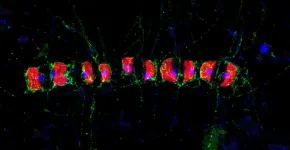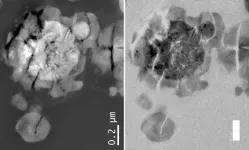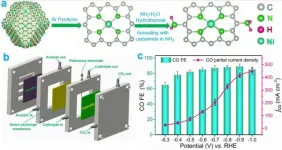(Press-News.org) The major direct and indirect effects of covid-19 have forced the authorities to implement policies that strike a balance between minimizing the immediate health impact of the pandemic and containing the long-term damage to society arising from protective policies.
One parameter that is crucial for calculating how restrictive policies might be warranted is the mortality impact of covid-19, which has led to large-scale international collaborations in order to collect data that records deaths attributable to the pandemic.
Despite the limitations, each of these research avenues and associated health measures (infection rate, deaths and excess deaths) is important in order to inform the public and policymakers about the mortality impact of covid-19.
"Our results confirm that the mortality impact of covid-19 is large, not only in terms of numbers of deaths, but also in terms of years of life lost".
A study by a group researchers from several international universities and research centres, including lecturers from the UPF Department of Economics and Business Héctor Pifarré i Arolas (first author) and Guillem López Casasnovas, both researchers at the Centre for Research in Health and Economics (CRES-UPF), has estimated the premature mortality impact of covid-19. It has done so by calculating years of life lost (YLL) due to covid-19 compared to YLL for other common illnesses, such as the flu or cardiovascular diseases.
The research, published recently in the journal Scientific Reports (Nature Research), also involved the researchers Mikko Myrskylä, Enrique Acosta and Tim Riffe (Max Planck Institute for Demographic Research, Germany); Adeline Lo (University of Wisconsin-Madison, USA), and Catia Nicodemo (University of Oxford) and has been co-funded by the "la Caixa" Foundation.
"Our results confirm that the mortality impact of covid-19 is large, not only in terms of numbers of deaths, but also in terms of years of life lost", assert the authors, who consider their study a snapshot of the situation of the pandemic in early 2021.
How many years of life have been lost due to covid-19? And in relation to other illnesses?
The years of life lost rate is the difference between an individual's age at death and their life expectancy. The researchers estimated YLL caused by covid-19 using data on more than 1,279,866 deaths in 81 countries. They also analysed data on life expectancy and made projections of total deaths from covid-19 by country.
The authors estimate that a total of 20,507,518 years of life have been lost due to covid-19 in the 81 countries included in this study.
The authors estimate that a total of 20,507,518 years of life have been lost due to covid-19 in the 81 countries included in this study, with an average of sixteen years per individual death. Of the total YLL, 44.9% occurred in individuals between 55 and 75 years of age, 30.2% among people under 55, and 25% in the over 75s. In the countries for which records of the number of deaths by sex were available, YLL was 44% higher in men than in women.
The life years lost rate due to the pandemic has been between two and nine times greater than the mean YLL rate associated with seasonal flu.
In the countries most affected by covid-19, and in relation to other global common causes of death, the life years lost rate due to the pandemic has been between two and nine times greater than the mean YLL rate associated with seasonal flu, and between 1/4 and 1/2 higher than the YLL rate attributable to heart disease.
Interpretation of the results in the context of an evolving pandemic
In 35 of the countries studied, the data coverage spans at least nine months; in these cases, this suggests that it will probably include the full impacts of the pandemic in 2020, or at least its first waves, while for other countries, these figures are still rising. The authors warn that "these results must be understood in the context of an ongoing, evolving pandemic; this study is a snapshot of the possible impacts of covid-19 on years of life lost on January 6, 2021".
"Estimates of years of life lost may be underestimated, due to the difficulty of accurately recording covid-19-related deaths".
Moreover, the authors suggest that "estimates of years of life lost may be underestimated, due to the difficulty of accurately recording covid-19-related deaths", since "both policies and practices about coding the deaths are only just being developed and standardized". In addition, they stress that the study is limited to analysing premature mortality, and that a full assessment of the impact of the pandemic on health should consider the burden of disability associated with the disease.
INFORMATION:
Apart from support from the "la Caixa" Foundation, this research has received funding from the Social Sciences and Humanities Research Council and the Fonds du Recherche du Québec - Société et Culture (Canada) and from the University of Oxford's Covid-19 Research Response Fund (Great Britain).
Reference article: "Years of life lost to COVID-19 in 81 countries", (February 2021). Pifarré i Arolas, H., Acosta, E., López Casasnovas, G., Lo A., Nicodemo, C., Riffe, T., Myrskylä, M. Scientific Reports
DOI: 10.1038/s41598-021-83040-3
When can tuberculosis therapy be stopped without risk of relapse? Doctors are faced with this question time and again, because the lack of detection of the tuberculosis pathogen Mycobacterium tuberculosis is no guarantee for a permanent cure of the lung infection. Patients who respond to the standard therapy may be out of treatment after six months. But for resistant cases, more than 18 months of treatment duration is currently advised. "This is a very long time for those affected, who often have to take more than four antibiotics every day and suffer from side effects", explains Prof. Dr. Christoph Lange, Clinical Director at the Research Center Borstel and director of the study, conducted at the German Center for Infection Research (DZIF) in cooperation with the German Center for ...
A group of researchers has developed a new program showing participation and activity is critical for the rehabilitation of older adults in long-term care.
The results of their research were published in the journal PLOS ONE on February 12, 2021.
"Our study shows participatory programs that encourage elderly patients to be active need greater emphasis in elderly care centers," said Yoshihiko Baba, lead author of the study.
In 2015, the Ministry of Health, Labour and Welfare of Japan launched a comprehensive plan to care for the country's aging population. Crucial to this was rehabilitation centered on promoting activities that elderly patients could actively take part in.
Baba, a former ...
Although amber looks like a somewhat unusual inorganic mineral, it is actually derived from an organic source - tree resins. Millions of years ago, when this aromatic and sticky substance was slowly oozing from coniferous trees, insects and other biological material could become trapped in it. That is why some samples of amber contain fossilized specimens, preserved in a virtually pristine state, which afford fascinating snapshots of the flora and fauna of long-gone forests. Now, a research team led by LMU zoologists Viktor Baranov and Joachim Haug has made exciting ...
Semi-trucks and other heavy-duty vehicles are responsible for nearly half of road transportation carbon dioxide emissions in Europe, according to the International Council on Clean Transportation. A team of researchers in Italy has proposed a plan to reduce the emissions without compromising priorities such as delivery times. They published their approach in IEEE/CAA Journal of Automatica Sinica, a joint publication of the IEEE and the Chinese Association of Automation.
"Driving style, traffic and weather conditions have a significant impact on vehicle fuel consumption. Road freight traffic, in particular, contributes ...
A major pathway for carbon sequestration in the ocean is the growth, aggregation and sinking of phytoplankton - unicellular microalgae like diatoms. Just like plants on land, phytoplankton sequester carbon from atmospheric carbon dioxide. When algae cells aggregate, they sink and take the sequestered carbon with them to the ocean floor. This so called biological carbon pump accounts for about 70 per cent of the annual global carbon export to the deep ocean. Estimated 25 to 40 per cent of carbon dioxide from fossil fuel burning emitted by humans may have been transported by this process from the atmosphere to depths below 1000 meter, where carbon can be stored for millennia. ...
Early Mars is considered as an environment where life could possibly have existed. There was a time in the geological history of Mars when it could have been very similar to Earth and harbored life as we know it. In opposite to the current Mars conditions, bodies of liquid water, warmer temperature, and higher atmospheric pressure could have existed in Mars' early history. Potential early forms of life on Mars should have been able to use accessible inventories of the red planet: derive energy from inorganic mineral sources and transform CO2 into biomass. Such living entities are rock-eating microorganisms, called "chemolithotrophs", which ...
The ability to speak is one of the essential characteristics that distinguishes humans from other animals. Many people would probably intuitively equate speech and language. However, cognitive science research on sign languages since the 1960s paints a different picture: Today it is clear, sign languages are fully autonomous languages and have a complex organization on several linguistic levels such as grammar and meaning. Previous studies on the processing of sign language in the human brain had already found some similarities and also differences between sign ...
The last complete reversal of the Earth's magnetic field, the so-called Laschamps event, took place 42,000 years ago. Radiocarbon analyses of the remains of kauri trees from New Zealand now make it possible for the first time to precisely time and analyse this event and its associated effects, as well as to calibrate geological archives such as sediment and ice cores from this period. Simulations based on this show that the strong reduction of the magnetic field had considerable effects in the Earth's atmosphere. This is shown by an international team led by Chris Turney from the Australian University of New South Wales, with the participation of Norbert Nowaczyk from the German Research Centre for ...
Researchers at Tampere University have successfully used artificial intelligence to predict nonlinear dynamics that take place when ultrashort light pulses interact with matter. This novel solution can be used for efficient and fast numerical modelling, for example, in imaging, manufacturing and surgery. The findings were published in the prestigious Nature Machine Intelligence journal.
Artificial intelligence can distinguish different types of laser pulse propagation, just as it recognizes subtle differences of expression in facial recognition. The newly found solution can make it simpler to design experiments in fundamental research and will allow algorithms ...
Carbon dioxide (CO2) electrocatalytic reduction driven by renewable electricity can solve the problem of excessive CO2 emissions. Since CO2 is thermodynamically stable, efficient catalysts are needed to reduce the energy consumption in the process.
The single-atom catalysts immobilized on nitrogen-doped carbon supports (M-N/C) have been widely used for CO2 electrocatalytic reduction reaction due to their high atom utilization efficiency.
Recently, a research team led by Prof. LIU Licheng from the Qingdao Institute of Bioenergy and Bioprocess Technology (QIBEBT) of the Chinese Academy of Sciences (CAS) proposed a two-step amination strategy to regulate the electronic structure of M-N/C catalysts (M=Ni, Fe, Zn) and enhance the intrinsic activity of CO2 electrocatalytic reduction.
In ...





